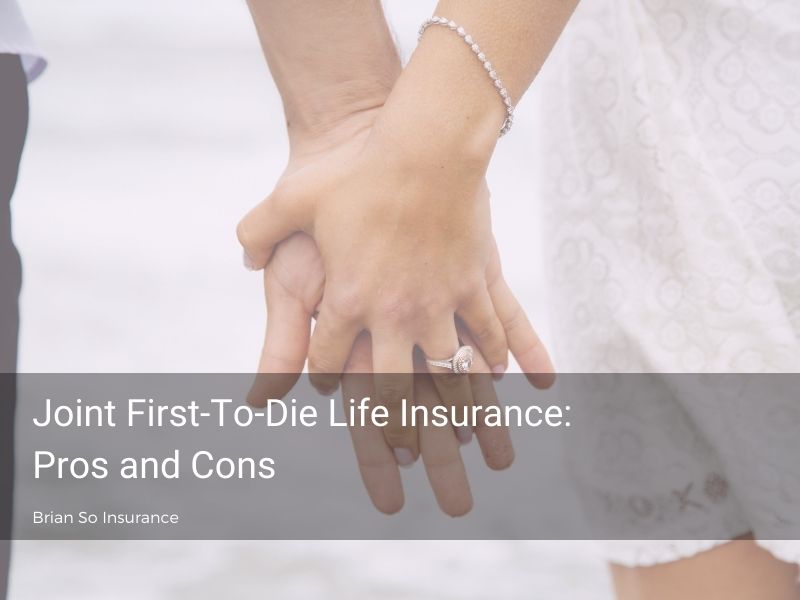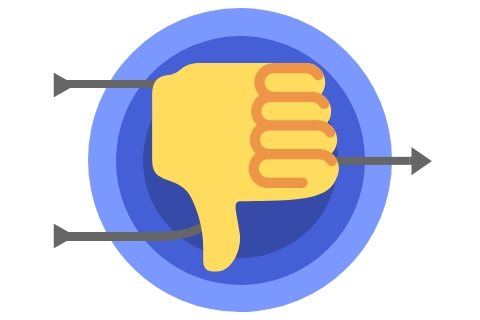Table of contents
Did you know that a life insurance policy can cover more than one life?
One of these types of policies, joint last-to-die, pays a death benefit on the last death of two or more people.
The other, joint first-to-die, pays out when the first person in a couple passes away.
In this post, we will explore the advantages and drawbacks of joint first-to-die life insurance coverage and whether it offers the financial protection you need.

What Can You Use Joint First-To-Die Life Insurance Policies For?

Debt repayment
The most practical use of joint first-to-die life insurance policies for young families is to use the entire death benefit to pay off the mortgage in the event of an unexpected death.
Because the mortgage is usually the largest debt you have, we tend to focus on it when we talk about debt.
But you can use the death benefit to pay off any other type of debt with a joint first-to-die life insurance policy. This includes credit cards, lines of credit, small business loans, and more.
The goal is to relieve the burden of debt payments for the surviving spouse.
This is especially important if the survivor is not the breadwinner. How can he/she continue to afford the recurring payments without an income?
Even if the surviving spouse is the main income earner, he/she can take an extended period of time off work to grieve without worrying about the debt load and income loss.
Income replacement
While debt management is a primary reason for getting a joint first-to-die life insurance policy, you shouldn’t overlook its use as income replacement either.
If both you and your spouse have similar income levels, when the first insured dies, the surviving partner can use the death benefit to replace the lost income.
Since one partner usually makes more than another, having two separate policies is more suitable for replacing lost income.
Business partners
A joint first-to-die life insurance policy is critical when used in a business setting.
Business partners are indispensable to the success of the business. Upon the unexpected death of a partner, the surviving partner will face financial difficulty. Here are three uses of joint life insurance when the first insured dies:
- The entire death benefit from a joint first-to-die life insurance policy can pay off any small business loans.
- It can also inject some emergency capital during a time of crisis.
- You can also use the proceeds of a joint life insurance policy to fund a buy-sell agreement.
Advantages Of Joint First-To-Die Life Insurance Policies

Double payout
A lesser-known benefit of joint life insurance policies is that in the case of simultaneous deaths, the policy pays the death benefit twice!
For example, if both you and your spouse die in a car or flight accident, your beneficiaries will receive double the payout.
The contract stipulates that the deaths don’t have to happen at the exact same time, but there is a limited period of time. For example, the surviving partner is automatically covered within the first 90 days of the first death. This gives the surviving spouse temporary life insurance coverage.
While simultaneous deaths are rare, this is one of those benefits that are nice to have built into the policy.
Conversion
Another feature found in some insurance companies’ joint life policies is the ability to convert a joint life insurance policy into permanent insurance, without providing medical evidence of insurability.
What does this mean?
It means even if your health has deteriorated, you can convert the joint policy without having to qualify for it medically. So you can skip the medical exam and other probing medical questions.
The new life insurance policy can either be joint last-to-die or two separate policies, which provides more flexibility in case you need to split the joint policy in the future.
Why would you need to convert a term life policy into a permanent one? Two words: insurance needs.
Term insurance coverage is good for temporary needs, while permanent (joint last-to-die) life insurance is suitable for long-term needs.
Say your original purpose was for the life insurance policy to eliminate the mortgage. Fast forward 25 years and you’ve paid it off entirely. The temporary need is for life insurance coverage is now gone.
But you still have a permanent need for life insurance, like to pay for funeral expenses, taxes at death, probate fees and executor fees. In other words, you need a joint last-to-die life insurance policy for estate planning purposes.
If over the years your health has declined and you’re not eligible for life insurance coverage anymore, you can convert that joint first-to-die life insurance policy into a joint last-to-die one without needing to apply for a new policy.
Insurance for the surviving spouse
Most joint life insurance policies also include a provision for the surviving spouse to purchase a single life insurance policy within a certain time period after the first death (between 30-90 days).
The surviving partner must be below a certain age (e.g. 70) and does not have to provide medical evidence of insurability. Like the conversion option, a medical exam is not required.
This is useful if the surviving partner has developed health issues and won’t qualify for a new life insurance policy.
The maximum they can buy is equal to the face amount of the original policy. For example, if the original joint policy had a death benefit of $500,000, then that is the maximum the surviving spouse can buy on their single life insurance policy after the first death.
Savings
You would think that because the insurance company only pays out once, a joint first-to-die life insurance policy is much cheaper than two individual policies which has double the coverage, right?
In some cases, you’d be correct.
For example, one insurance company provides savings of over 30% on its term-10 joint life policies compared to two single lives.
Another provides savings of less than 5%.
Insurance companies are always updating their rates, so these numbers are always changing.
By the way, you can’t quote for joint first-to-die life insurance using any quotation tool online. That’s because these tools don’t show all the life insurance products. So if you want to find out which insurance company provides the best savings, use the form at the bottom of the page. We will email the quote to you.
Or continue reading to find out the drawbacks of joint first-to-die life insurance.
Drawbacks Of Joint First-To-Die Policies

Lack of flexibility
The main drawback of a joint first-to-die life insurance policy is the lack of flexibility compared to two individual life insurance policies.
With some companies, you may not be able to split the joint life insurance policy into two separate policies.
Why would you want to do this?
One reason—and nobody plans for this—is because of divorces and separations.
If this happens, the original purpose for getting the joint life policy likely doesn’t make sense anymore. Splitting the policy will let each person control their own policy, change beneficiaries, death benefit, and more.
This flexibility can prove to be invaluable, especially years down the road when health issues may preclude you from qualifying for a new policy.
Preferred rates
Preferred underwriting can reduce your life insurance premium by up to 30%, potentially saving you thousands of dollars over the life of the policy.
But here’s the deal:
Getting a policy issued with preferred rates isn’t easy.
You have to adhere to strict limits for factors like blood pressure, cholesterol level, weight, family history, and more.
It’s difficult enough qualifying for it on a single life policy.
With a joint life policy? Both of you have to qualify.
If one of you was eligible for preferred rates but the other only standard rates, the policy will be issued at standard rates.
With a single life policy, at least one person would have received some savings.
The problem with single equivalent age
The single equivalent age is the age that the insurance company uses to determine the premium on joint life insurance policies.
It does this by combining the ages and gender of the two insured.
For example, a 40-year-old male and female couple may have a single equivalent age of a 48-year-old male. Therefore, the premium for the joint first-to-die life insurance policy will be the same as a 48-year-old male.
The problem with using a single equivalent age arises when you have age-related benefits.
For example, all term policies have a conversion provision that allows you to convert it into a permanent policy, up to a certain age, usually 71.
If the couple had two single life policies, they would both have 31 years (71 minus 40) to convert to permanent insurance.
But if they bought a joint first-to-die life insurance policy, then the insurance company uses their single equivalent age to calculate their deadline to convert.
So in this case, they would only have 23 years (71 minus 48) to convert to permanent insurance.
That’s a loss of 8 years on their conversion privilege!
And that’s not all:
If they choose to convert at age 50, instead of paying age 50 premiums as they would on single life policies, the premium for the permanent policy will be based on their single equivalent age of 58.
There is a huge difference in premium between a 50-year-old and a 58-year-old!
How Much Do Joint First-To-Die Life Insurance Policies Cost?
Ok, so you think joint first-to-die life insurance is right for you. But how much does it cost?
While it’s impossible to show quotes for all the different combinations of ages, below are the monthly premiums for $1,000,000 of joint first-to-die coverage between non-smoking males and females for select ages.
In the table below, term-10 means that the premium is level in the first 10 years. Starting in year 11, it increases and is level again from years 11-20. The increase can be substantial, so you’re better off choosing a longer term from the beginning instead of renewing a term-10 policy.
Some insurance companies increases the premium every year starting in year 11. While the rate hikes are more manageable, the renewal premiums are still much higher than during the first 10 years.
For term-20, the renewal starts in year 21.
Age | Term-10 | Term-20 |
|---|---|---|
25 | $37 | $52 |
30 | $40 | $60 |
35 | $53 | $84 |
40 | $73 | $133 |
45 | $118 | $219 |
50 | $180 | $373 |
55 | $302 | $683 |
60 | $624 | $1,264 |
65 | $1,077 | $2,046 |
Is Joint First-To-Die Life Insurance Coverage Right For You?
Does joint first-to-die life insurance offer the financial protection you need?
Is it better than getting two single life policies with double the coverage?
If you’re using it for paying off debt or income replacement between two similar income levels, then you can consider it.
But if the lack of flexibility worries you or you need two separate insurance payouts, then buying separate policies is the way to go.
If you need more information, we are always available at info@briansoinsurance.com or a quick phone call away at 604-928-1628. We’ll be happy to explain joint first-to-die life insurance in more detail and give you a free quotation.
You can also use the tool below to request a quote.
Get Your Joint First-To-Die Life Insurance Quote Now
While we make every effort to keep our site updated, please be aware that timely information on this page, such as quote estimates, or pertinent details about companies, may only be accurate as of its last edit day. Brian So Insurance and its representatives do not give legal or tax advice. Please consult your own legal or tax adviser. This post is a brief summary for indicative purposes only. It does not include all terms, conditions, limitations, exclusions, and other provisions of the policies described, some of which may be material to the policy selection. Please refer to the actual policy documents for complete details which can be provided upon request. In case of any discrepancy, the language in the actual policy documents will prevail. A.M. Best financial strength ratings displayed are not a warranty of a company’s financial strength and ability to meet its obligations to policyholders.


I am an insurance professional looking for a true “first to die” life insurance policy and can’t find a company that sells one. I’m checking with Transamerica but a search of their website on “first to die” yields no results. If anyone knows of a company that sells this product, I would appreciate it if they’d let me know.
joint first to die policies are generally trash. high premiums for one payout unless both party dies at the same time or within 60 days of the first persons death. the survivor generally is able to setup a new policy without having to go through underwriting but has to pay at the new age. savings are less than 15% for a joint policy so it’s not worth the savings.
Hi John, thanks for the comment. Joint first-to-die has its place in certain situations. For example, it’s a great replacement for mortgage life insurance, especially if you choose a reducing death benefit option.
Please quote joint life insurance term, first to die. male age 77, female age 59, $30,000
Hi John, please check your email for the quote.
What companies still offer 1st to die term or ul policies?
Les T
Hi Les, plenty of insurance companies still offer joint first-to-die term and UL policies. Please email us if you would like a specific quote, thanks.
Please quote joint first to die male 63 (smoker) female 51 (non smoker) $100, 000
I have an adviser that has asked about a joint FIRST to die contract. My firm represents multiple carriers but none offer this option. Can you provide a list of carriers which do offer this type of product? Thanks.
How much for first to die policy for us: Husband 72, wife 71
both non-smokers, wife perfect health, husband good health
Hi Judi, thank you for your inquiry. Please check your email for the quote.
My now exhusband and I purchased a joint first to die policy, in Nova Scotia, while still married. I am now unable to find out much about the policy. I have the policy number only. Since I no longer have the same representative the company tells my new representative that they can not tell me anything about the policy. My question is, can the policy be cancelled or changes made without my knowledge?
Hi Donna, you should sign a servicing agent change form indicating you would like your new agent to represent you. If you don’t, they won’t be able to tell him/her anything. You should still be able to approach the insurance company directly for information regarding your policy.
To answer your question, there are some changes that can be made because of inaction on your part. For example, if you have a policy that was on premium offset (using dividends to pay the premium) and the dividends run out, the insurance company may decrease your coverage or lapse your policy. Active changes such as changing the owner, beneficiary, coverage amount, etc, cannot be made without the authorization of the owner.
Are there still companies that off first-to-die joint term life insurance?
Hi Katie. Yes, most of them do.
Hi Brian
Can you please provide Best quote Comparison for JFTD and individual insurance for husband, 49 and wife, 50? Looking for combination of T10-300k, T20-300k, T30-100k and T100-60k. Both non-drinker and non-smoker. Please indicate if there is survivor coverage in effect for JFTD. If none, what’s the best option can you recommend. Thanks much
Are there any JFTD policies available as guaranteed insurability issue?
Hi Teresa, yes there are. The same companies that offer guaranteed issue products have JFTD policies available.
looking for options from carriers with Joint First Right to Die. Term for 15 or 20 years – husband 59, wife 60. both still working full time, in good health. non smokers. thanks
Hi Mary, please check your email inbox for more information, thanks.
Can you offer a quote for joint first to die life insurance for $400K wife age 60 good health, husband age 59 with some minor cancer history (thyroid)
Hi Susan, please check your email for the quote.
Hi Brian,
can I get a proposal for 1st to die life:
Deena – 11/7/66, female, preferred non smoker, Massachusetts
Steve – 7/15/66, male, preferred non smoker, Massachusetts
1mm coverage, solve for premium for policy to last 15 years, then lapse… otherwise, if duration is beyond 15 years, what is shortest duration we can solve for paying premiums all years?
thanks, Eric Bertz
508-450-9578
Hi Eric, thanks for the request. Unfortunately, we’re not licensed in the US so I can’t provide a quote for you.
Hi Brian,
Can you please quote JFTD Term 20 $1.5million, JFTD Term 20 $750,000 and JFTD Term 10 $750,000 for Male 47 and Female 41?
Thanks!
Hi Irene, please check your email inbox, thanks.
How much for first to die policy for us: Husband 70, wife 66
both non-smokers, husband and wife perfect health?
Thanks very much
keith
Could you give me a quote on a male 58 diabetic overweight, female 58, both smoke.
First to die policy and length of time for $100,000 or $200,000
Hi, can you provide a quote for first to die policy? Husband 61, wife 60, both non-smokers. $200,000
Thanks